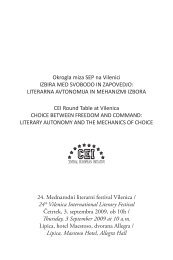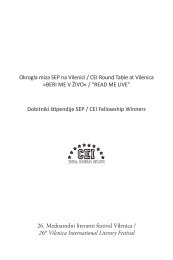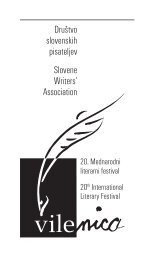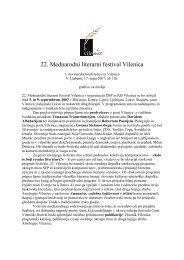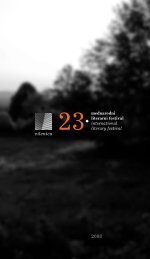- Page 2 and 3: V2-2010.PM526/13/100, 12:13 PM25. M
- Page 4 and 5: V2-2010.PM546/13/100, 12:13 PMMlada
- Page 6 and 7: V2-2010.PM566/13/100, 12:13 PMMedna
- Page 8 and 9: V2-2010.PM586/13/100, 12:13 PMDžev
- Page 10 and 11: V2-2010.PM5106/13/100, 12:13 PMDže
- Page 12 and 13: V2-2010.PM5126/13/100, 12:13 PMDže
- Page 14 and 15: V2-2010.PM5146/13/100, 12:13 PMDže
- Page 16 and 17: V2-2010.PM5166/13/100, 12:13 PMDže
- Page 18 and 19: V2-2010.PM5186/13/100, 12:13 PMJana
- Page 22 and 23: V2-2010.PM5226/13/100, 12:13 PMJana
- Page 24 and 25: V2-2010.PM5246/13/100, 12:13 PMDže
- Page 26 and 27: V2-2010.PM5266/13/100, 12:13 PMDže
- Page 28 and 29: V2-2010.PM5286/13/100, 12:13 PMDže
- Page 30 and 31: V2-2010.PM5306/13/100, 12:13 PMDže
- Page 32 and 33: V2-2010.PM5326/13/100, 12:13 PMThe
- Page 34 and 35: V2-2010.PM5346/13/100, 12:13 PMDže
- Page 36 and 37: V2-2010.PM5366/13/100, 12:13 PMDže
- Page 38 and 39: V2-2010.PM5386/13/100, 12:13 PMDže
- Page 40 and 41: V2-2010.PM5406/13/100, 12:13 PMDže
- Page 42 and 43: V2-2010.PM5426/13/100, 12:13 PMDže
- Page 44 and 45: V2-2010.PM5446/13/100, 12:13 PMDže
- Page 46 and 47: V2-2010.PM5466/13/100, 12:13 PMDže
- Page 48 and 49: V2-2010.PM5486/13/100, 12:13 PMMax
- Page 50 and 51: V2-2010.PM5506/13/100, 12:13 PMKili
- Page 52 and 53: V2-2010.PM5526/13/100, 12:13 PMMax
- Page 54 and 55: V2-2010.PM5546/13/100, 12:13 PMMax
- Page 56 and 57: V2-2010.PM5566/13/100, 12:13 PMKili
- Page 58 and 59: V2-2010.PM5586/13/100, 12:13 PMMax
- Page 60 and 61: V2-2010.PM5606/13/100, 12:13 PMJace
- Page 62 and 63: V2-2010.PM5626/13/100, 12:13 PMJace
- Page 64 and 65: V2-2010.PM5646/13/100, 12:13 PMJace
- Page 66 and 67: V2-2010.PM5666/13/100, 12:13 PMJace
- Page 68 and 69: V2-2010.PM5686/13/100, 12:13 PMJace
- Page 70 and 71:
V2-2010.PM5706/13/100, 12:13 PMJace
- Page 72 and 73:
V2-2010.PM5726/13/100, 12:13 PMKris
- Page 74 and 75:
V2-2010.PM5746/13/100, 12:13 PMKris
- Page 76 and 77:
V2-2010.PM5766/13/100, 12:13 PMKris
- Page 78 and 79:
V2-2010.PM5786/13/100, 12:13 PMKris
- Page 80 and 81:
V2-2010.PM5806/13/100, 12:13 PMWhat
- Page 82 and 83:
V2-2010.PM5826/13/100, 12:13 PMKris
- Page 84 and 85:
V2-2010.PM5846/13/100, 12:13 PMVero
- Page 86 and 87:
V2-2010.PM5866/13/100, 12:13 PMOran
- Page 88 and 89:
V2-2010.PM5886/13/100, 12:13 PMSpre
- Page 90 and 91:
V2-2010.PM5906/13/100, 12:13 PMVero
- Page 92 and 93:
V2-2010.PM5926/13/100, 12:13 PMVero
- Page 94 and 95:
V2-2010.PM5946/13/100, 12:13 PMVaja
- Page 96 and 97:
V2-2010.PM5966/13/100, 12:13 PMLudw
- Page 98 and 99:
V2-2010.PM5986/13/100, 12:13 PMLudw
- Page 100 and 101:
V2-2010.PM51006/13/100, 12:13 PMLud
- Page 102 and 103:
V2-2010.PM51026/13/100, 12:13 PMLud
- Page 104 and 105:
V2-2010.PM51046/13/100, 12:13 PMEne
- Page 106 and 107:
V2-2010.PM51066/13/100, 12:13 PMEne
- Page 108 and 109:
V2-2010.PM51086/13/100, 12:13 PMEne
- Page 110 and 111:
V2-2010.PM51106/13/100, 12:13 PMEne
- Page 112 and 113:
V2-2010.PM51126/13/100, 12:13 PMEne
- Page 114 and 115:
V2-2010.PM51146/13/100, 12:13 PMEne
- Page 116 and 117:
V2-2010.PM51166/13/100, 12:13 PMBla
- Page 118 and 119:
V2-2010.PM51186/13/100, 12:13 PMBla
- Page 120 and 121:
V2-2010.PM51206/13/100, 12:13 PMBla
- Page 122 and 123:
V2-2010.PM51226/13/100, 12:13 PMBla
- Page 124 and 125:
V2-2010.PM51246/13/100, 12:13 PMBla
- Page 126 and 127:
V2-2010.PM51266/13/100, 12:13 PMBla
- Page 128 and 129:
V2-2010.PM51286/13/100, 12:13 PMSal
- Page 130 and 131:
V2-2010.PM51306/13/100, 12:13 PMSal
- Page 132 and 133:
V2-2010.PM51326/13/100, 12:13 PMSal
- Page 134 and 135:
V2-2010.PM51346/13/100, 12:13 PMSal
- Page 136 and 137:
V2-2010.PM51366/13/100, 12:14 PMSal
- Page 138 and 139:
V2-2010.PM51386/13/100, 12:14 PMSal
- Page 140 and 141:
V2-2010.PM51406/13/100, 12:14 PMRad
- Page 142 and 143:
V2-2010.PM51426/13/100, 12:14 PMUso
- Page 144 and 145:
V2-2010.PM51446/13/100, 12:14 PMRad
- Page 146 and 147:
V2-2010.PM51466/13/100, 12:14 PMRad
- Page 148 and 149:
V2-2010.PM51486/13/100, 12:14 PMRad
- Page 150 and 151:
V2-2010.PM51506/13/100, 12:14 PMTar
- Page 152 and 153:
V2-2010.PM51526/13/100, 12:14 PMTar
- Page 154 and 155:
V2-2010.PM51546/13/100, 12:14 PMTar
- Page 156 and 157:
V2-2010.PM51566/13/100, 12:14 PMTar
- Page 158 and 159:
V2-2010.PM51586/13/100, 12:14 PMTar
- Page 160 and 161:
V2-2010.PM51606/13/100, 12:14 PMTar
- Page 162 and 163:
V2-2010.PM51626/13/100, 12:14 PMTar
- Page 164 and 165:
V2-2010.PM51646/13/100, 12:14 PMVik
- Page 166 and 167:
V2-2010.PM51666/13/100, 12:14 PMVik
- Page 168 and 169:
V2-2010.PM51686/13/100, 12:14 PMKon
- Page 170 and 171:
V2-2010.PM51706/13/100, 12:14 PMVik
- Page 172 and 173:
V2-2010.PM51726/13/100, 12:14 PMVik
- Page 174 and 175:
V2-2010.PM51746/13/100, 12:14 PMVik
- Page 176 and 177:
V2-2010.PM51766/13/100, 12:14 PMMaj
- Page 178 and 179:
V2-2010.PM51786/13/100, 12:14 PMMaj
- Page 180 and 181:
V2-2010.PM51806/13/100, 12:14 PMMaj
- Page 182 and 183:
V2-2010.PM51826/13/100, 12:14 PMMaj
- Page 184 and 185:
V2-2010.PM51846/13/100, 12:14 PMMaj
- Page 186 and 187:
V2-2010.PM51866/13/100, 12:14 PMJoa
- Page 188 and 189:
V2-2010.PM51886/13/100, 12:14 PMJoa
- Page 190 and 191:
V2-2010.PM51906/13/100, 12:14 PMJoa
- Page 192 and 193:
V2-2010.PM51926/13/100, 12:14 PMJoa
- Page 194 and 195:
V2-2010.PM51946/13/100, 12:14 PMJoa
- Page 196 and 197:
V2-2010.PM51966/13/100, 12:14 PMJoa
- Page 198 and 199:
V2-2010.PM51986/13/100, 12:14 PMJoa
- Page 200 and 201:
V2-2010.PM52006/13/100, 12:14 PMJoa
- Page 202 and 203:
V2-2010.PM52026/13/100, 12:14 PMJoa
- Page 204 and 205:
V2-2010.PM52046/13/100, 12:14 PMIll
- Page 206 and 207:
V2-2010.PM52066/13/100, 12:14 PMIll
- Page 208 and 209:
V2-2010.PM52086/13/100, 12:14 PMIll
- Page 210 and 211:
V2-2010.PM52106/13/100, 12:14 PMIll
- Page 212 and 213:
V2-2010.PM52126/13/100, 12:14 PMIll
- Page 214 and 215:
V2-2010.PM52146/13/100, 12:14 PMIll
- Page 216 and 217:
V2-2010.PM52166/13/100, 12:14 PMIll
- Page 218 and 219:
V2-2010.PM52186/13/100, 12:14 PMOct
- Page 220 and 221:
V2-2010.PM52206/13/100, 12:14 PMOct
- Page 222 and 223:
V2-2010.PM52226/13/100, 12:14 PMOct
- Page 224 and 225:
V2-2010.PM52246/13/100, 12:14 PMOct
- Page 226 and 227:
V2-2010.PM52266/13/100, 12:14 PMOct
- Page 228 and 229:
V2-2010.PM52286/13/100, 12:14 PMOct
- Page 230 and 231:
V2-2010.PM52306/13/100, 12:14 PMVer
- Page 232 and 233:
V2-2010.PM52326/13/100, 12:14 PMVer
- Page 234 and 235:
V2-2010.PM52346/13/100, 12:14 PMVer
- Page 236 and 237:
V2-2010.PM52366/13/100, 12:14 PMVer
- Page 238 and 239:
V2-2010.PM52386/13/100, 12:14 PMVer
- Page 240 and 241:
V2-2010.PM52406/13/100, 12:14 PMJá
- Page 242 and 243:
V2-2010.PM52426/13/100, 12:14 PMJá
- Page 244 and 245:
V2-2010.PM52446/13/100, 12:14 PMJá
- Page 246 and 247:
V2-2010.PM52466/13/100, 12:14 PMJá
- Page 248 and 249:
V2-2010.PM52486/13/100, 12:14 PMJá
- Page 250 and 251:
V2-2010.PM52506/13/100, 12:14 PMThr
- Page 252 and 253:
V2-2010.PM52526/13/100, 12:14 PMJá
- Page 254 and 255:
V2-2010.PM52546/13/100, 12:14 PMSuz
- Page 256 and 257:
V2-2010.PM52566/13/100, 12:14 PMSuz
- Page 258 and 259:
V2-2010.PM52586/13/100, 12:14 PMSuz
- Page 260 and 261:
V2-2010.PM52606/13/100, 12:14 PMSuz
- Page 262 and 263:
V2-2010.PM52626/13/100, 12:14 PMGor
- Page 264 and 265:
V2-2010.PM52646/13/100, 12:14 PMZak
- Page 266 and 267:
V2-2010.PM52666/13/100, 12:14 PMGor
- Page 268 and 269:
V2-2010.PM52686/13/100, 12:14 PMGor
- Page 270 and 271:
V2-2010.PM52706/13/100, 12:14 PMAgn
- Page 272 and 273:
V2-2010.PM52726/13/100, 12:14 PM.Ag
- Page 274 and 275:
V2-2010.PM52746/13/100, 12:14 PM.Ag
- Page 276 and 277:
V2-2010.PM52766/13/100, 12:14 PMNas
- Page 278 and 279:
V2-2010.PM52786/13/100, 12:14 PM.Ag
- Page 280 and 281:
V2-2010.PM52806/13/100, 12:14 PM.Ag
- Page 282 and 283:
V2-2010.PM52826/13/100, 12:14 PMAri
- Page 284 and 285:
V2-2010.PM52846/13/100, 12:14 PMAri
- Page 286 and 287:
V2-2010.PM52866/13/100, 12:14 PMAri
- Page 288 and 289:
V2-2010.PM52886/13/100, 12:14 PMAri
- Page 290 and 291:
V2-2010.PM52906/13/100, 12:14 PMAri
- Page 292 and 293:
V2-2010.PM52926/13/100, 12:14 PMAri
- Page 294 and 295:
V2-2010.PM52946/13/100, 12:14 PMC.
- Page 296 and 297:
V2-2010.PM52966/13/100, 12:15 PMC.
- Page 298 and 299:
V2-2010.PM52986/13/100, 12:15 PMC.
- Page 300 and 301:
V2-2010.PM53006/13/100, 12:15 PMC.
- Page 302 and 303:
V2-2010.PM53026/13/100, 12:15 PMC.
- Page 304 and 305:
V2-2010.PM53046/13/100, 12:15 PM304
- Page 306 and 307:
V2-2010.PM53066/13/100, 12:15 PMMla
- Page 308 and 309:
V2-2010.PM53086/13/100, 12:15 PMMla
- Page 310 and 311:
V2-2010.PM53106/13/100, 12:15 PMMla
- Page 312 and 313:
V2-2010.PM53126/13/100, 12:15 PMMla
- Page 314 and 315:
V2-2010.PM53146/13/100, 12:15 PM314
- Page 316 and 317:
V2-2010.PM53166/13/100, 12:15 PMDos
- Page 318 and 319:
V2-2010.PM53186/13/100, 12:15 PMDos
- Page 320 and 321:
V2-2010.PM53206/13/100, 12:15 PMDos
- Page 322 and 323:
V2-2010.PM53226/13/100, 12:15 PMDos
- Page 324 and 325:
V2-2010.PM53246/13/100, 12:15 PMDos
- Page 326 and 327:
V2-2010.PM53266/13/100, 12:15 PMDos
- Page 328 and 329:
V2-2010.PM53286/13/100, 12:15 PMKON



